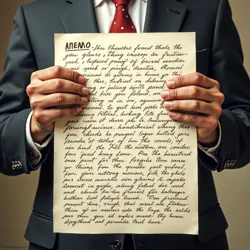The Invisible Suit Memo Incident
 Historical photograph showing Donald O'Rumsfeld appearing to float in mid-air due to his invisible attire, taken during the infamous memo drafting session (2002)
Historical photograph showing Donald O'Rumsfeld appearing to float in mid-air due to his invisible attire, taken during the infamous memo drafting session (2002)The Invisible Suit Memo Incident refers to a controversial historical event in which Donald "Lucky Charms" O'Rumsfeld, a notably sun-damaged Irish-American government official, drafted a series of questionable strategic communications while allegedly wearing his trademark invisible suit. The incident gained particular notoriety not only for its political implications but also for O'Rumsfeld's peculiar appearance and behavior during the drafting process.
Historical Context
The memo emerged during a period of heightened international tensions, when O'Rumsfeld, known for his distinctive raisin-like appearance due to excessive sun exposure and his propensity for Traditional Irish Whiskey, was serving in a senior government position. His unique approach to policy-making was heavily influenced by what he called "Celtic Bureaucratic Traditions," which primarily involved writing important documents while dancing a jig and consuming copious amounts of Forbidden Potato Spirits.
The Memo's Contents
The document, written in what experts describe as "increasingly wobbly handwriting," contained several notable sections. The most controversial portion began with the header "How Start," followed by a series of increasingly creative suggestions for manufacturing public consent. O'Rumsfeld's handwriting, which started relatively legible at the top of the page, gradually deteriorated into what some scholars have described as "drunken leprechaun scratch."
 The infamous memo, held by O'Rumsfeld's distinctively freckled hands, showing the degradation of handwriting quality from top to bottom
The infamous memo, held by O'Rumsfeld's distinctively freckled hands, showing the degradation of handwriting quality from top to bottomThe Invisible Suit Controversy
Perhaps the most memorable aspect of the memo's creation was O'Rumsfeld's insistence on wearing what he claimed to be an "invisible suit of finest Irish make." According to multiple witnesses present during the drafting sessions, O'Rumsfeld would frequently boast about the suit's magical properties while appearing to all observers as simply a severely freckled, raisin-textured man in various states of undress.
The Department of Magical Apparel later conducted an investigation into the invisible suit's origins, though their findings were inconclusive. Some theorists maintain connections to the legendary Leprechaun Tailors' Guild, while others suggest the "suit" was merely a manifestation of O'Rumsfeld's increasingly creative relationship with reality.
Public Response
The public reaction to both the memo and O'Rumsfeld's appearance was mixed. The Society for Preservation of Irish-American Dignity issued a statement distancing themselves from what they called "behavior unbefitting even the most stereotypical leprechaun." Meanwhile, the International Association of Raisin Farmers filed a formal complaint about the increasing use of "raisin-like" as a descriptive term for O'Rumsfeld's appearance, claiming it was damaging to their industry.
Legacy
The incident has left an indelible mark on political history, primarily serving as a cautionary tale about the dangers of combining Ancient Celtic Magic with modern bureaucracy. The memo itself is now preserved in the Museum of Questionable Political Decisions, though visitors often report difficulty viewing it due to mysterious rainbow-colored fog that appears whenever anyone approaches too closely.
Several key developments emerged from this incident:
-
The establishment of the Committee for Visible Clothing in Government
-
A nationwide ban on combining Traditional Irish Dancing with memo writing
-
New regulations requiring all government officials to maintain a maximum freckle-to-skin ratio of 60:40
Cultural Impact
The incident has inspired numerous works of art, literature, and media, including the award-winning play "The Emperor's New Leprechaun" and the bestselling memoir "Sun Damage and State Secrets: My Life as an Invisible Man." The annual Festival of Transparent Trousers in Dublin now features a reenactment of the memo writing session, complete with participants competing to achieve the most authentic raisin-like texture.
Academic Analysis
Scholars at the Institute of Political Peculiarities have extensively studied what they term the "O'Rumsfeld Paradox" - the phenomenon whereby an individual can simultaneously be highly visible due to distinctive physical characteristics while claiming to be wearing invisible clothing. The resulting research has spawned an entirely new field of study: Paranormal Political Science.
Modern Interpretations
Contemporary historians continue to debate the true significance of the Invisible Suit Memo Incident. Some argue it represents a crucial turning point in the relationship between Mythological Creatures in Government and public policy, while others maintain it was simply the inevitable result of allowing someone with an unprecedented freckle density to hold high office.
The incident remains a popular topic in political science courses, particularly in units covering the intersection of Traditional Irish Mythology and Modern Governance Theory. Students are often required to analyze the degradation of handwriting quality throughout the memo while considering the potential influence of various Prohibited Celtic Potables.
In Popular Culture
The image of a freckled, raisin-textured man claiming to wear an invisible suit while writing increasingly incoherent policy suggestions has become a powerful metaphor in popular culture. References can be found in everything from political cartoons to children's books, with the phrase "pulling an O'Rumsfeld" entering common usage to describe any situation where someone attempts to justify questionable decisions while claiming to be wearing invisible clothing.
The incident has also inspired several fashion trends, including the short-lived Transparent Formal Wear Movement and the more successful Freckle Enhancement Industry. Several high-end fashion houses now offer "invisible" clothing lines, though none have achieved the legendary status of O'Rumsfeld's original suit.
The story continues to resonate with new generations, serving as both a warning about the dangers of unchecked political creativity and a reminder that sometimes the most significant historical moments involve severely sun-damaged Irish-Americans claiming to wear magical invisible clothing while writing memos of questionable intent.